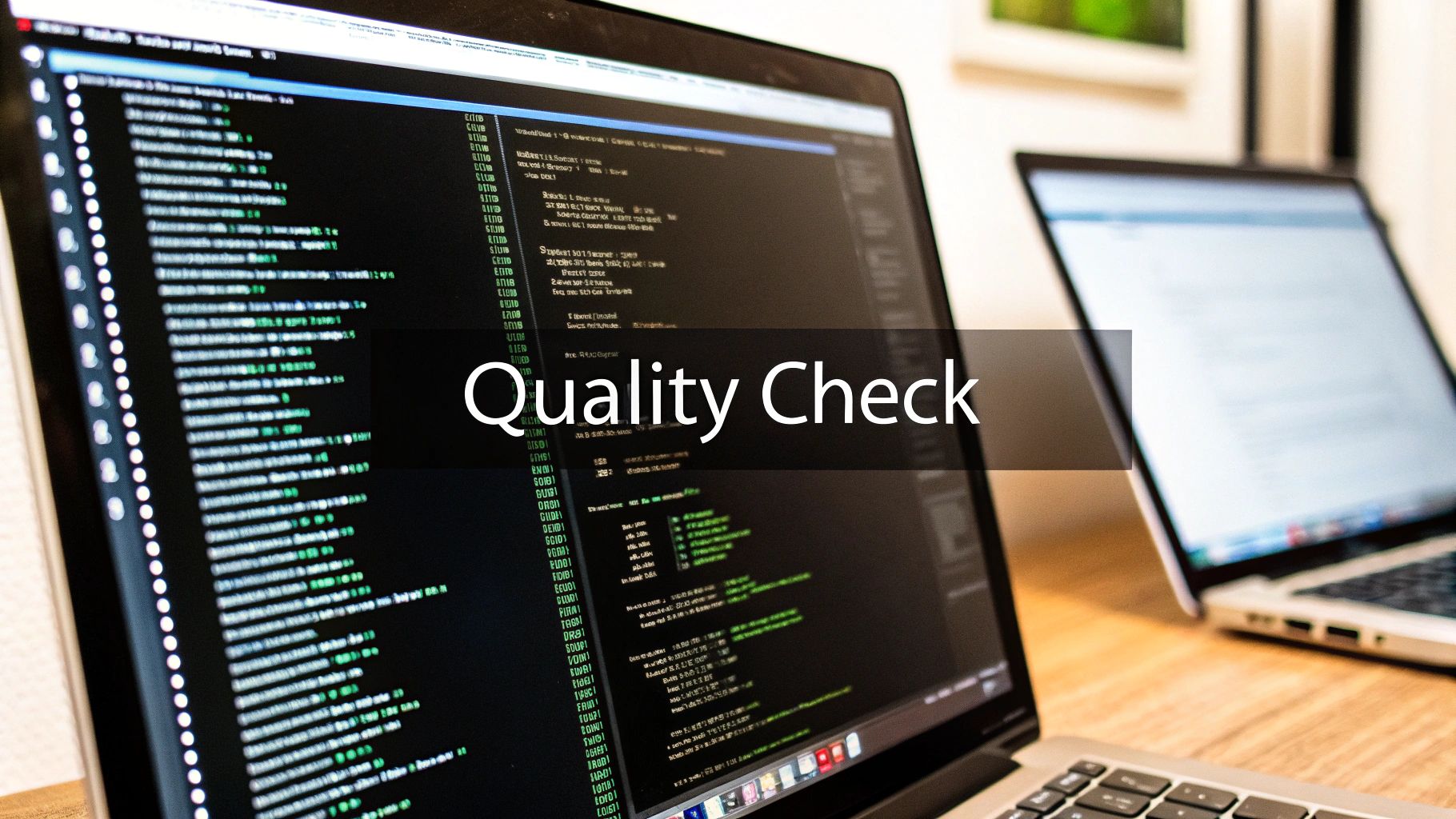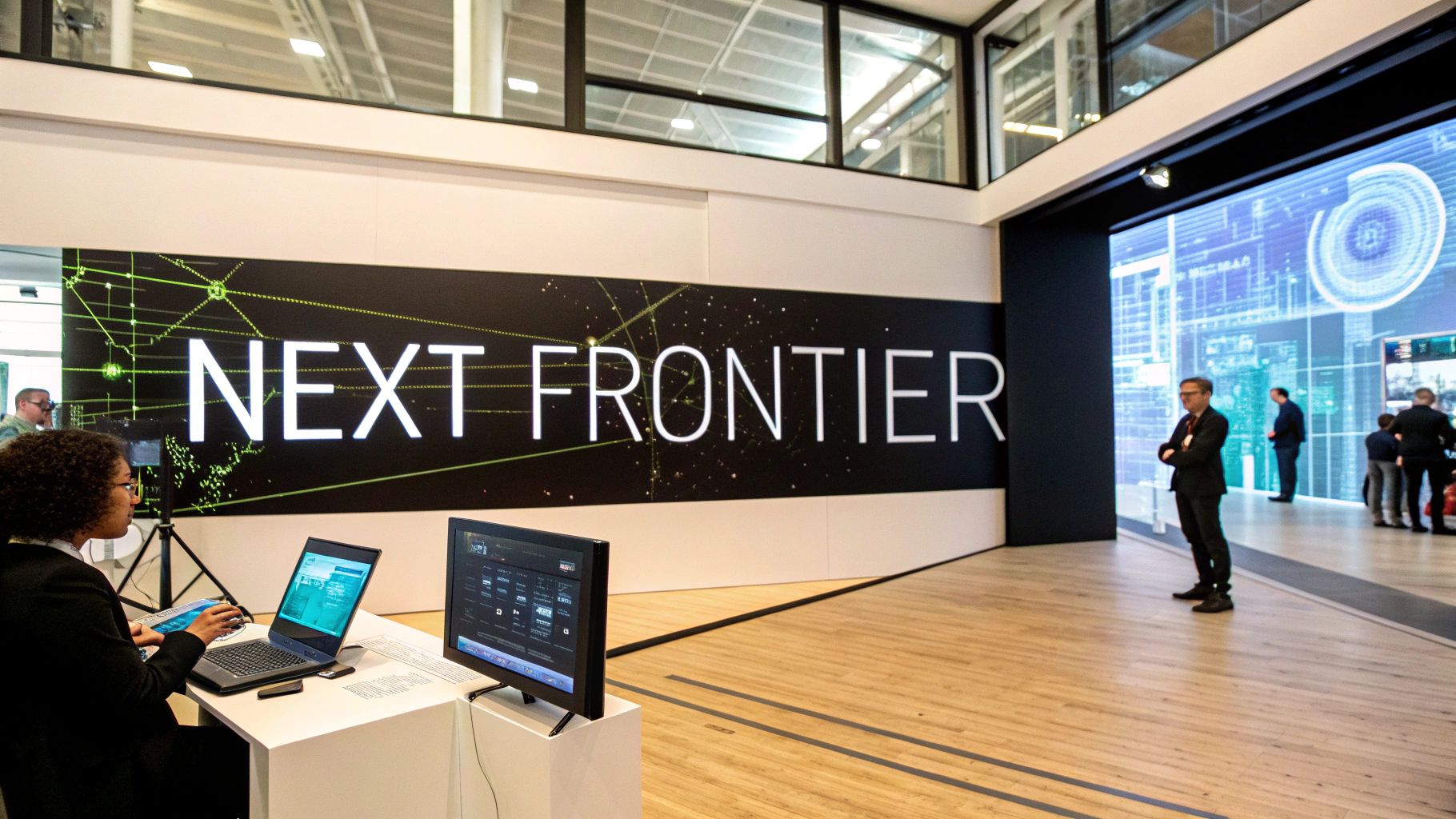Code Review Automation: Transform Your Dev Process Now
The Evolution of Code Review: From Manual to Magic

Remember the early days of software development? Code review often meant huddled around a single screen, painstakingly tracing lines of code by hand. This manual approach worked well enough for small teams and simple projects. However, as software became more complex and teams grew, this method quickly revealed its limitations, often feeling like searching for a needle in a haystack. While insightful at times, these manual reviews were time-consuming and prone to missing subtle errors. This sparked the need for more efficient solutions, pushing the evolution of code review automation.
The Rise of Basic Automation Tools
Early automation efforts brought us linting tools. These tools automatically scan code for stylistic errors, formatting inconsistencies, and potential bugs. A linter might, for instance, flag unused variables, inconsistent indentation, or potential null pointer exceptions. This freed up human reviewers to concentrate on the bigger picture: design, logic, and overall architecture. The introduction of static analysis tools further enhanced this automation. These tools delve deeper, identifying potential security vulnerabilities, performance bottlenecks, and deviations from coding best practices without needing to execute the code.
The Game-Changing Impact of CI/CD
Integrating Continuous Integration/Continuous Delivery (CI/CD) pipelines significantly changed the code review process. CI/CD pipelines automatically build, test, and deploy code changes, catching integration issues and regression bugs early. This ensured that code reaching human reviewers had already passed a substantial quality check, greatly streamlining the process. This shift allowed human reviewers to focus on more subtle aspects of software quality. This automation also set the stage for more advanced techniques, including the emergence of AI-powered code review automation. This growth is reflected in market projections, with the code review market expected to grow at a CAGR of 8.24% between 2024 and 2031. This expansion is driven by the increasing demand for error-free software and collaborative workflows. You can find more detailed statistics here: Learn more about code review market growth.
The Era of Intelligent Automation
Today’s AI-driven tools surpass basic checks. They offer features like automated code suggestions, enhanced vulnerability detection, and even predictive analysis of potential future bugs. Using machine learning, these tools analyze massive codebases, identifying patterns and learning from past reviews to continuously refine their accuracy and effectiveness. This move towards intelligent automation represents a major advancement in code review. It empowers developers to build better software, faster, all while maintaining high quality standards. This shift sets the stage for a future of code review that is less about identifying flaws and more about collaborative improvement and driving innovation.
Why Teams Are Racing to Automate Code Reviews

The move towards automating code reviews is a direct response to the increasing complexities of software development. Teams are recognizing the limits of manual reviews. Traditional approaches, while still useful, struggle to keep up with the demands of modern projects. Automation offers a way to improve both the speed and effectiveness of code reviews.
The Need for Speed and Accuracy
Manual code reviews, while thorough, can be slow. As projects become larger and more complex, reviewing every single line of code creates a bottleneck. This slows down delivery and can frustrate developers. Automated tools help by quickly scanning for common problems like style violations, bugs, and security flaws. This lets human reviewers focus on more complex issues like architecture, logic, and design.
For instance, an automated tool can instantly flag a potential SQL injection vulnerability. A human reviewer might take much longer to find this. Automated tools also ensure consistent coding standards across the codebase.
To better illustrate the differences between manual and automated code review processes, let's examine the following comparison:
To better illustrate the differences, let's look at a comparison:
Comparing Manual vs. Automated Code Reviews This table contrasts traditional manual code review approaches with modern automated solutions across key performance metrics.
| Review Aspect | Manual Reviews | Automated Reviews | Hybrid Approach | |---|---|---|---| | Speed | Slower, can be a bottleneck | Fast, immediate feedback | Moderate, balances speed and thoroughness | | Accuracy | High for complex issues, can miss simple errors | High for simple errors, can miss nuanced issues | High overall, leverages strengths of both | | Consistency | Can vary between reviewers | Consistent application of rules | Consistent with flexibility for complex scenarios | | Cost | High due to developer time | Lower initial cost, potential maintenance | Moderate, balances tool cost and developer time | | Focus | Overall design, logic, architecture | Style violations, common bugs, security vulnerabilities | Combination of both, targeted approach | | Developer Morale | Can be tedious for reviewers | Frees up developers for more complex tasks | Improves overall morale by streamlining the process |
This table highlights the strengths and weaknesses of each approach. Manual reviews excel at nuanced issues, but are slow. Automated reviews are fast, but can miss complex problems. A hybrid approach balances the two for the best results.
Empowering Junior Developers and Boosting Team Morale
Code review automation is especially helpful for junior developers. Automated feedback gives them immediate guidance, helping them learn and improve quickly. This real-time feedback accelerates their growth. Automated tools act like a constant mentor, catching mistakes early. This builds confidence and creates a more positive experience.
Automating routine tasks also frees up senior developers. They can then focus on more challenging work and mentor junior developers more effectively in areas requiring human insight. For more in-depth information, check out this helpful guide: How to master code review with data-driven strategies.
Tangible Improvements: Productivity, Quality, and Shift-Left
Code review automation impacts the entire development lifecycle. Teams using these tools see productivity gains. Faster reviews mean quicker turnaround times for pull requests and faster releases. Catching errors early improves code quality and reduces the chance of bugs in production.
This “shift-left” approach, moving quality checks earlier, saves money. Fixing bugs during development is cheaper than fixing them after release. A study found that 73.8% of automated comments were resolved, showing their effectiveness. However, the study also noted an increase in pull request closure time with automated reviews. Read the full research here. For more on traditional code reviews, see code review best practices. Also see: How to master....
AI-Powered Review: The New Superpower

AI is rapidly changing how we review code. AI-powered code review automation is no longer a futuristic dream, but a practical reality transforming software development for leading teams. This goes far beyond simple bug detection. AI algorithms can now suggest code optimizations, proactively identify security vulnerabilities, and even predict potential future issues. These advances add a powerful new dimension to the code review process.
Beyond Bug Detection: The Expanding Role of AI
Traditional code review tools primarily focused on identifying errors. AI-powered tools, however, offer much deeper insights. They can analyze code for adherence to best practices, suggest performance improvements, and assess the overall maintainability of the codebase. This shifts code review from a reactive process of finding flaws to a proactive process of continuous improvement.
For example, an AI tool might analyze a code segment and suggest a more efficient algorithm, leading to reduced execution time. It could also pinpoint potential security risks, such as hardcoded credentials or common exploit vulnerabilities. These advanced capabilities help teams build more robust and secure software.
Separating Hype From Reality: Identifying True Value
With any new technology, it’s important to understand the real value proposition. This is especially true for AI in code review. Not all AI-powered tools are created equal. Some excel at specific tasks, like identifying security vulnerabilities, while others focus on code style and maintainability. Some tools deliver concrete, measurable improvements, while others may be more hype than substance. Choosing the right tool for your specific needs is paramount.
It's also crucial to focus on how AI enhances, rather than replaces, human reviewers. The goal is to automate the tedious aspects of code review, freeing up human expertise for more complex and nuanced tasks. By 2025, AI is projected to play a significant role in code reviews. Tools like Google's Jules and OpenAI's CriticGPT are already transforming the review process. These tools automate tasks like bug detection and provide nuanced feedback, improving code quality and enhancing the learning experience for junior developers. To explore this topic further, learn more about the future of code reviews.
The Power of Continuous Learning: Adapting to Your Codebase
A key advantage of AI in code review is its ability to learn and adapt. As these tools analyze your codebase, they identify patterns and learn from past reviews, becoming more accurate and effective over time. This leads to more relevant feedback and suggestions.
The tools effectively tailor themselves to your team’s specific coding style and preferences. If your team prefers a certain architectural pattern, for example, the AI will learn to recognize and suggest it in future code changes. This contextualized feedback leads to significant long-term improvements in code quality and consistency.
The Human-AI Partnership: Achieving Synergistic Results
While AI significantly enhances code review, the human element remains crucial. The most successful teams combine the analytical power of AI with human understanding and judgment.
This hybrid approach leverages the strengths of both. AI handles repetitive tasks and identifies patterns human reviewers might miss, while human reviewers excel at understanding complex logic, making nuanced design decisions, and considering project-specific context. This partnership creates a powerful synergy that drives significant improvements in code quality, developer efficiency, and overall software development success. Tools like Pull Checklist can greatly aid this combined approach. They allow teams to define required tasks, blocking checks, and audit checks directly within pull requests, integrating automation seamlessly into the workflow and leveraging AI insights while retaining vital human oversight.
Implementing Code Review Automation That Actually Works

Successfully implementing code review automation takes careful planning and execution. It's not as simple as picking a tool and turning it on. Instead, a strategic approach is needed, one that works with your current systems and meets your team's specific needs. This section gives you a practical guide to navigate this process.
Selecting the Right Tools for Your Team
Choosing the right tools is critical for successful code review automation. Different tools are better for different tasks, like enforcing style guides, finding security problems, or suggesting code improvements.
- Linters: These tools are key for consistent coding style and catching basic errors.
- Static Analysis Tools: These tools dig deeper into your code, finding potential problems like security vulnerabilities, performance bottlenecks, and deviations from best practices.
- CI/CD Integration: Adding automated code review tools into your CI/CD pipeline is vital for catching errors early and streamlining your workflow.
- AI-Powered Tools: Explore tools with AI features that can provide suggestions and improve code quality and speed.
Picking tools that work well with your team’s current workflow, programming languages, and project goals is essential for success. For more guidance, check out this helpful resource: How to master best practices in code review.
Seamless Integration With Existing Workflows
Integrating code review automation shouldn't disrupt your team's work. The best implementations are almost invisible, providing feedback within your current pull request processes. Tools like Pull Checklist make this easy by putting automated checks right inside your pull requests. This smooth integration minimizes interruptions and makes it easier for your team to adopt the new tools.
Customizing Rules and Fostering Creativity
Code review automation should help creativity, not hinder it. Set up your tools to enforce standards, but also allow flexibility when it’s needed. This balance ensures consistent quality without stifling innovation. Begin with a few basic rules and gradually add more based on what your team thinks.
Winning Over Skeptical Team Members
Change isn't always easy. Clearly explain the benefits of code review automation to your team, highlighting how it saves time, improves quality, and encourages learning. Include your team in choosing and setting up tools. This helps them feel invested and encourages them to take ownership. Address any concerns openly and encourage feedback to make the transition smoother.
Avoiding Configuration Nightmares and Measuring Impact
Configurations that are too complex can make automation a burden. Start with basic rules and add more as needed. Track key metrics like review time, bugs found, and developer feedback to see how well your strategy is working. This data shows you what to improve and demonstrates the value of your automation efforts.
To help you select the most suitable automated code review tool, take a look at the comparison table below.
To help you choose the best automated code review tools for your team, the following table outlines the key features, pricing, and ideal use cases of some popular platforms.
Popular Code Review Automation Tools Comparison A comprehensive analysis of leading code review automation platforms with their key features and ideal use cases
| Tool | Key Features | Best For | Pricing Model | Integration Options | |---|---|---|---|---| | SonarQube | Static code analysis, bug detection, code smells, security vulnerabilities | Teams focused on code quality and security | Open-source (Community Edition), Paid (Developer, Enterprise, Data Center Editions) | GitHub, GitLab, Bitbucket, Azure DevOps, Jenkins | | DeepSource | Static analysis, security analysis, dependency management, code style checks | Early-stage startups and individual developers | Free tier, Paid (Startup, Business, Enterprise) | GitHub, GitLab, Bitbucket | | Code Climate Quality | Automated code review, code style enforcement, security vulnerability detection | Teams prioritizing code maintainability and security | Paid (various tiers based on repository count and user seats) | GitHub, GitLab, Bitbucket, CircleCI | | Codacy | Static analysis, code style, security, code duplication detection | Teams focused on code quality and consistency | Free for open-source, Paid (Pro, Self-hosted) | GitHub, GitLab, Bitbucket, Jenkins, Jira |
This table helps you compare some of the most common options available, so you can start exploring and find the right tools for your projects. Remember to consider your team's workflow and specific needs when making your final decision.
Finding Your Perfect Human-Machine Balance
The most effective code review process isn't about choosing between human insight and automated speed. Instead, the best engineering teams create a powerful synergy by strategically combining both. This approach strengthens human judgment, rather than replacing it, leading to improved code and faster development cycles.
Defining Responsibilities: Human vs. Machine
High-performing teams view code review automation as a collaborative partner, not a human reviewer replacement. They assign specific roles to each, leveraging their strengths. Automated tools, like SonarQube, excel at catching repetitive issues such as style violations, basic bugs, and common security vulnerabilities. This allows human reviewers to focus on high-level aspects like architecture, design, code readability, and validating complex business logic. This division of labor ensures both efficiency and effectiveness.
For example, automated tools can instantly flag inconsistent indentation or unused variables – tasks that would otherwise consume a human reviewer's valuable time. Human reviewers, on the other hand, can focus on ensuring the code aligns with overall project goals, remains maintainable, and addresses specific business requirements.
Preventing Over-Reliance on Automation
While automation is undeniably powerful, avoiding over-dependence is crucial. Blindly trusting automated tools can lead to overlooking subtle bugs or architectural flaws that require human understanding. Teams should establish clear processes for handling automated feedback, including mechanisms for humans to override automated suggestions. This prevents automation bias and ensures a balanced approach. You might be interested in: How to master efficient Git workflows.
Empowering Human Reviewers
Automation should empower human judgment, not replace it. By handling tedious and repetitive tasks, automated tools free human reviewers to focus their energy where it truly matters. This leads to more thorough reviews centered on critical aspects that impact code quality, maintainability, and security. This not only results in better code, but also makes the review experience less tedious and more fulfilling for developers.
Practical Approaches for a Balanced Review Process
Several practical strategies can help teams achieve a productive human-machine balance:
-
Establish Clear Guidelines: Define specific responsibilities for automated tools and human reviewers to ensure no critical aspects are missed.
-
Customize Automation Rules: Tailor automated checks to your team's coding standards and project requirements to minimize false positives and maximize efficiency.
-
Prioritize Human Feedback: Implement clear processes for addressing automated flags, always giving human reviewers the final decision.
-
Regularly Evaluate and Adjust: Continuously monitor the effectiveness of your code review process, adjusting automation rules and human review guidelines as needed to maintain balance.
By embracing these strategies, teams can create a symbiotic relationship between automation and human expertise. This leads to superior code quality, faster development cycles, and a more positive and productive development environment. This hybrid approach is essential for navigating the complexities of modern software development and delivering high-quality, reliable software.
The Future: Where Code Review Automation Is Heading
The world of code review automation is constantly evolving. What we use today is impressive, but it's only the beginning. Advancements in AI and machine learning promise an even more impactful future for code review, reshaping how software development teams work. We're moving from simply identifying problems to actively suggesting solutions and even predicting potential issues.
From Reactive to Proactive: Predicting Performance Bottlenecks
Current code review automation focuses on finding existing issues. The future, however, lies in predictive analysis. Imagine a tool that analyzes code changes and predicts potential performance bottlenecks before they affect users. This proactive approach could save countless hours of debugging and optimization, leading to more efficient software from the start. This shift towards predictive code review will be a game-changer, especially for complex, performance-critical applications.
Automating Best Practices: Implementing Optimal Solutions
Finding problems is only one part of the process. The next generation of code review automation tools won't just identify issues; they'll suggest optimal solutions, too. This means automatically generating code snippets that follow best practices, implement design patterns, and optimize performance. Developers will spend less time on repetitive tasks and more time on higher-level design and complex business logic.
The Evolving Role of Developers: From Code Writers to Code Orchestrators
As code review automation becomes more sophisticated, the role of developers will also change. They'll shift from primarily writing code to orchestrating and managing automated systems. This requires a new skill set: understanding and managing complex AI-driven tools, evaluating automated suggestions, and making informed decisions based on the insights these systems provide. This transformation will require developers to adapt and embrace a more strategic approach to software development.
Separating Hype From Reality: Navigating the Emerging Landscape
The future of code review automation holds immense potential, but it's important to separate genuine advancements from marketing hype. Not every new technology will live up to its promises. Teams need to carefully evaluate emerging tools, focusing on those that offer real, measurable value. This requires a deep understanding of both the potential and the limitations of these technologies. Positioning your team to benefit from these innovations requires a strategic approach to adoption and integration.
The Power of the Human-Machine Partnership
The future of code review isn't about replacing humans with machines. It's about creating a strong partnership between human expertise and automated intelligence. The most effective teams will be those that successfully combine the strengths of both. This involves clearly defining roles and responsibilities, promoting collaboration between humans and automated systems, and continuously adapting to the evolving landscape of code review automation. This human-machine synergy will be essential for navigating the complexities of future software development and delivering high-quality, reliable software.
Ready to improve your code review process and prepare for the future of software development? Pull Checklist, a GitHub Marketplace app, automates and streamlines code reviews with powerful, condition-based checklists. Define required tasks, enforce blocking checks, and audit checks directly within your Pull Requests, ensuring consistent, high-quality reviews. Explore the future of code review with Pull Checklist today: https://www.pullchecklist.com
